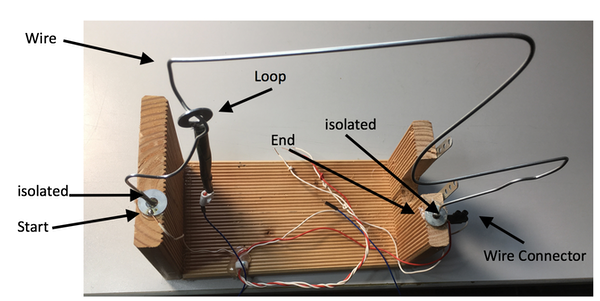7/25/2016 Started working on it...
Because you were so exited about Eric’s Wire Loop Game, I started on Sunday with the sketch and today with the hardware prototype. Let’s see, when I have time to go on…
8/02/2016 Video Clip of the first running prototype
During the weekend I was able to finish the first prototype. I struggled with some problems. Unfortunately I discovered that I’m getting quite old already. How? In May I wrote here about my experiences with interrupts. Less than 3 months later I’ve forgotten almost everything. Not only some details but e.g. that only some few pins of the Arduino can be used for interrupts.
After learning a lot of things the second time I got it working. Not pretty fine, but… Here’s a short video clip about the version 8/1/2016:
As ever: By clicking the YouTube button, you can watch it in 1080p…
You’ll discover some bugs, which are corrected in a new version 8/2/2016 already:
- Two of the welcome screens are staying quite long. The mistake wasn’t the code but I copied the same code twice. So these screens are shown twice. Blody mistake…
- Some of the messages are delayed. That’s because of the LEDs, which are blinking prior the message. After discussion with Tim we decided to skip them. The status (e.g. hitting the wire) is shown by the LCD and also by the buzzer. No need to have LEDs in addition.
- The reaction time of the interrupts aren’t optimal. I discussed with a colleague and updated them. They’re running much better now.
I think the sketch is now so mature, I can publish it on the sketch page without blaming me...
What I formerly wrote about using tabs, I’ve moved to here...
3/22/2017 Update to version 2
During the last weeks Tim build a very great housing for this cache. Because it’s not published yet, I didn’t allowed me, to publish any picture, what I totally understand. But we discovered a problem: When the game was finished (e.g. the wire was hit by the handle) and Tim moved back the handle to the start, he sometimes hit the wire again. This forced the servo to chutter randomly.
He spoke with some other cache builders and they offered a lot of ideas, what could be the issue. One suggestion pointed into the right direction: At the begin I made all interrupts active up to the cacher would remove his batteries. This wasn’t a good approach. Now its working like this:
- At the start of the game all interrupts (S = start hit, H = wire hit and E = end hit) are off
- Going the first time into the loop, S is switched on, waiting the start to be hit
- When start was hit, S is switched off and H and E are switched off
- When the game is over (wire hit or time over or end hit) all interrupts are switched off
What to come next? Tim asked me to include again two LEDs: A green one showing the time running and a red one showing game over. This will become version 3…
And this I just did. I don’t have a prototype here in Germany, so it’s up to Tim to test. As soon as it’s working fine, I’ll update the sketch for download.
Tim is ready to put a video onto YouTube. I’ll put a link here as soon as it’s available...
3/23/2017 Update to version 3 - Called „Wire Game"
I just received a „100% perfect" from Tim. So this final version is now ready for download.
4/19/2017 - Video uploaded by Tim & this blog closed
After Tim uploaded his great video to YouTube, this blog is closed. Enjoy his video, because it’s not showing this unique cache, but gives you also some ideas about the principles of „smart“ caches:
